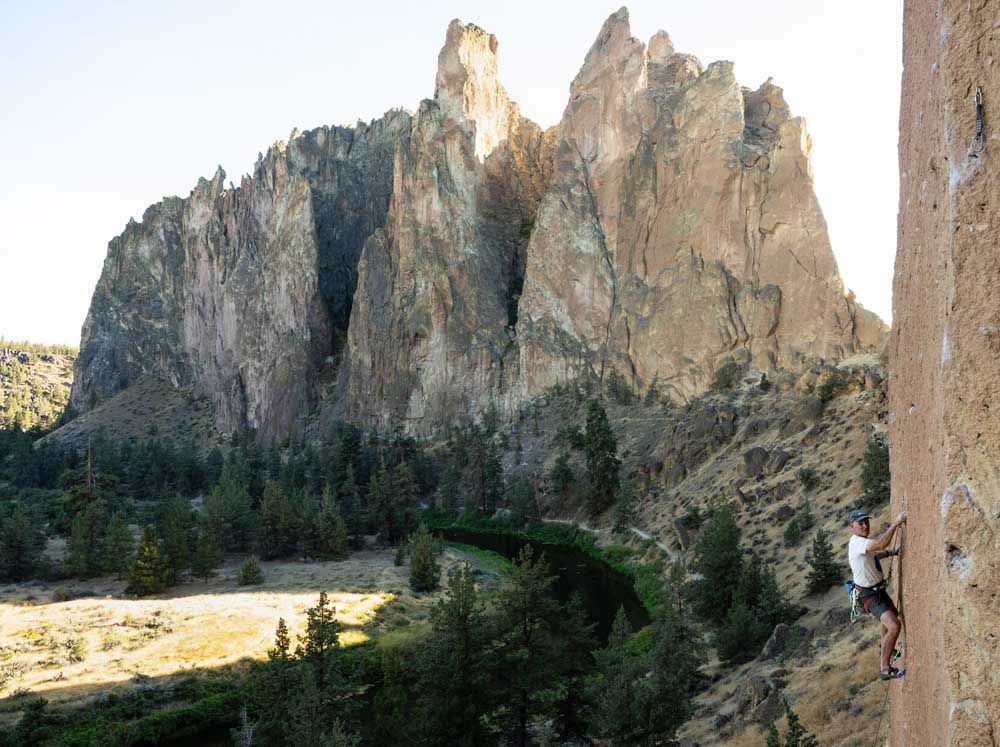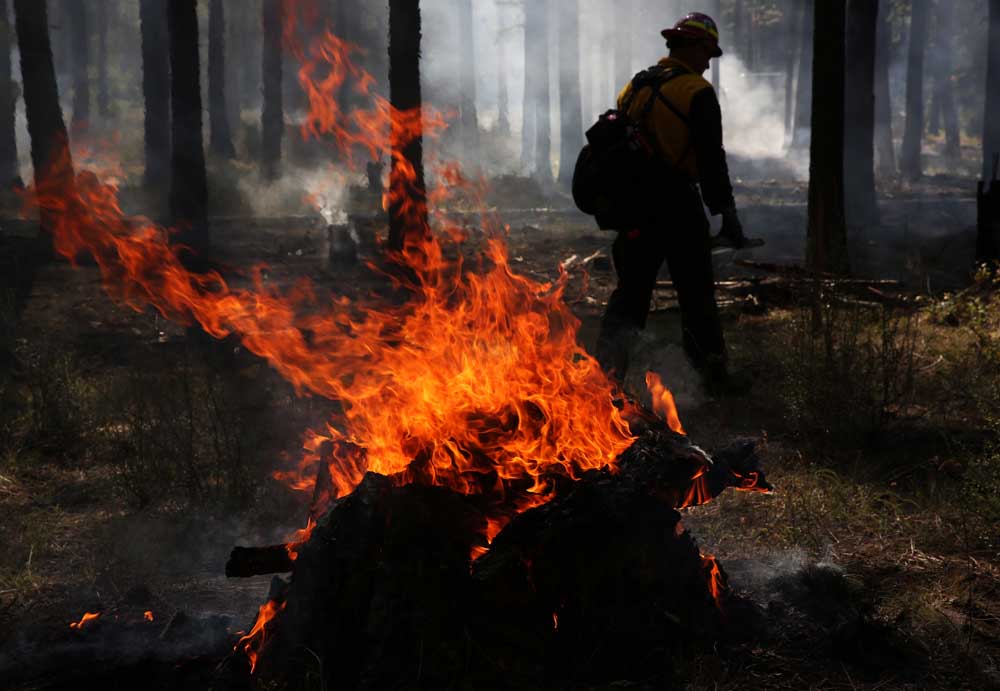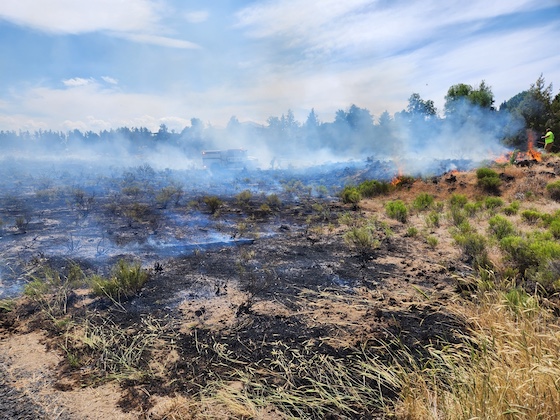Alan Watts, a sport climbing pioneer, releases third edition of his Smith Rock guidebook
Published 8:30 am Saturday, August 19, 2023

- Alan Watts pauses on a good hold on “Watts Tots” at Smith Rock State Park on Friday in Terrebonne. Watts got the first ascent of “Watts Tots” in February 1983, and hadn’t climbed the route since. “Watts Tots” is generally considered the first sport climb in North America.
In the early 1980s, when Alan Watts was busy revolutionizing rock climbing, he was lonely at Smith Rock State Park.
“There were no people at Smith Rock,” Watts recalled of his days spent establishing climbing routes. “And it’s hard to even comprehend when I say no people, I mean NO PEOPLE.”
Bend’s Watts, 63, remembers days when he would arrive in the morning and his would be the only car in the parking lot, and it would still be the only car when he left at night.
As perhaps the most influential individual in the evolution of American sport climbing, Watts has seen Smith Rock transform from a place with extremely difficult routes for only the most hard-core climbers to a destination where beginner to moderate climbers have their pick of routes that suit their ability. The parking lots are often full now and overcrowding has been an issue.
“I have mixed feelings about it, just like any of us who have lived in Central Oregon for a long time,” Watts said. “When it was just a few of us out there, those were fun days and it was great times. If nobody ever would have repeated my early routes or knew they were there, it still would have been worth it. But what’s really made it great for me is that there’s been so many followers and so many new generations of climbers coming in over and over again, and that’s just going to continue forever.”
Watts, who grew up in Madras and moved to Bend in 1983, spent much of the 1980s making first ascents and developing new climbing routes at Smith Rock. He achieved first ascents of some 250 climbs at Smith Rock, including Watts Tots, to begin the transformation of American sport climbing in early 1983. This year marks the 40th anniversary of that achievement.
Watts also placed the bolts in many of the park’s most famous routes, including ”Just Do It” on the Monkey Face — once considered the most challenging route in the park. In 1985, he achieved the first ascent of that route, at the time considered the hardest route in the country.
The third edition of Watts’ guidebook “Rock Climbing Oregon’s Smith Rock State Park” was released earlier this month and includes more than 2,200 climbing routes. (Rock climbers follow established routes up a wall, and clip into bolts that provide protection from long falls. A route typically ends at a set of anchors that the climber also clips into and then rappels back to the ground.)
An ‘explosion’ of new routes
The recent surge in the popularity of climbing at Smith Rock is evident in the sheer volume of new routes at the park.
“There was just this absolute explosion of new route activity, starting in 2016,” Watts said. “There were more than 650 new routes going up in like five or six years. That’s why the book took a long time to get done. The finish line … every time I thought I was getting close someone would show me a new crag at Smith Rock that had 40 new routes on it.”
Watts — who has a 29-year-old son and a 26-year-old daughter — said he now climbs only rarely, after developing joint problems in his fingers in the early 1990s from climbing. His most recent new route was in 2021.
“I still do them occasionally,” he said. “Every time I’m out there hiking around I still see potential routes that haven’t been climbed. I think, ‘I gotta do this, I can’t believe this hasn’t been done yet.’ Then I rememwber that I’m 63 years old and I don’t really want to go to the work of doing that.”
It is certainly easier now to get bolts into a rock wall than it was 40 years ago.
“Back when I was doing most of my routes, we didn’t have any battery technology where could use a power drill,” Watts said. “I had to hammer in the bolts by hand, which took way, way longer. Putting in a bolt back then took about an hour, now you can put in a bolt in two minutes.”
Routes on the climbing scale range from 5.0 (easiest) to 5.15a (most difficult). From 5.10 to 5.14, routes are broken down by a, b, c, and d (”a” being easiest, ”d” being hardest).
Climbs are given these ratings based on natural features of the rock, which include difficulty of holds and the steepness of the route.
More climbers, fewer elites
In the last few years, Alan Collins, of Sisters, has done about 300 new routes by himself at Smith Rock and about 200 of those are 5.12 or harder, according to Watts.
The most difficult route at Smith Rock is the Assassin, a 5.14d climbed in 2016 by Colorado’s Drew Ruana, then just 16 years old. Before that, the hardest route was Watts’ Just Do It, a 5.14c.
“In 31 years, it’s only gone up one grade,” Watts said. “There’s no 5.15’s at Smith Rock. There are 5.15’s in a dozen other states.”
While in the late 1980s and early 1990s, Smith Rock was THE place for hard climbs, that has changed as climbers seeking the most difficult routes find them in places like Colorado, Utah and Nevada.
“It was the first sport climbing area in the country,” Watts said of Smith Rock. “Now there’s hundreds and hundreds, and there’s other places with harder climbs. Smith is no longer where the hardest climbs in the world are. But back then there were 1,000 routes, now there’s 2,200.
“There’s more climbers visiting Smith Rock now than back then, it’s just not as much of the elite climbers. It’s actually a pretty good place now for somebody who’s just learning how to climb.”
Popularity fueled by climbing gyms
Watts said the surge in popularity of climbing is fueled by indoor climbing gyms, of which there are more than 700 in the U.S. that feed a billion dollar industry. Indoor sport climbing made its Olympic debut at the 2020 Tokyo Games.
Watts co-founded EP Climbing Walls in Bend in 1988 but he left the company in 1997.
“We were just kind of marginally profitable, and I didn’t really believe in the future of climbing gyms,” Watts admitted. “I made a bad bet. A lot of the early pioneers of the climbing wall industry, very few of them profited off that. Really it’s been in the last 15 years that the industry has exploded.”
Watts said a huge percentage of new outdoor climbers are mainly gym climbers, but that has helped make the sport of climbing so much bigger.
“For me it’s more winning than losing,” Watts said. “I kind of feel the same about Bend. It’s changed a lot, but we live in a vibrant community. And Smith Rock is certainly a vibrant climbing community.”









